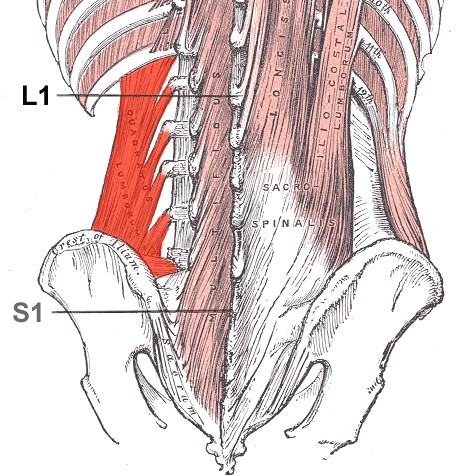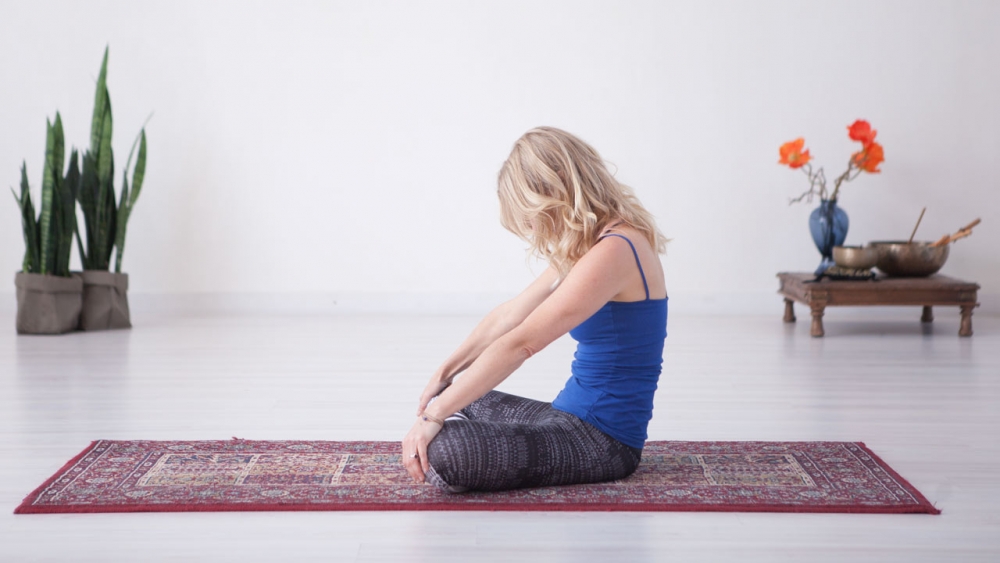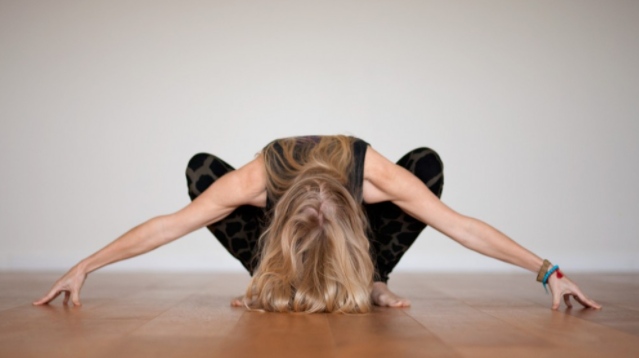The quadratus lumborum muscles, or QLs for short, are found on either side of the lumbar spine (lower back) and are important core muscles that help stabilise the lower back. They essentially connect the lower spine to the pelvis and assist with movements like side bending and raising the hip.
Many of you may know about these muscles in relation to back pain and they’re often the source of discussion when trying to identify lower back issues. However, they’re sometimes unfairly blamed as the sole culprit for pain and we can easily forget that the QL is just one part of a whole system of muscles that work together to support, stabilise and mobilise the spine.
They are very difficult to identify on your own body as they lay deep in the lower back and it’s nearly impossible to feel them yourself. If you place your hands on your hips (thumbs facing backwards) your thumbs will be hitting the edge (or close to it) of the point where the muscle attaches to the hip bone. A qualified bodywork specialist will be able to help you locate them.
In order to look after our QL we need to understand its relationship with the muscles around it, its anatomy and what we can do to strengthen it and release it. Let’s start with some anatomy!
Anatomy of the Quadratus Lumborum

The QL muscles are found on either side of the lumbar spine. They attach to the iliac crest (top of the hip bone), the transverse processes of the L1- L4 (lumbar vertebrae) and the twelfth rib (your last rib). Essentially they connect the hip to the lumbar spine and the lowest part of the rib cage.
Actions of the QL
Lateral flexion: When working unilaterally (only one side contracting), they laterally flex your spine, meaning you bend over to one side.
Extension: They can also extend the lumbar spine.
A good example of the lateral flexion and extension action of the QL in yoga would be Triangle Pose. One side contracts to aid lateral flexion and both muscles work to extend the spine, helping to keep your spine long as it bends to the side.
Stabilisation: They play a major role in stabilising the lower back, especially when seated. The QL is very active, for example, when you are sitting and even more so when bending sideways whilst sitting to pick something up off the floor.
Respiration: The QL also plays a role in inhalation – fixing the 12th rib when taking deep breaths or coughing – and helps the diaphragm to contract.
Elevator: It also acts as a hip ‘hiker’ – i.e. lifts the hip towards the rib cage.
Slow and fast twitch muscles
The quadratus lumborums are considered to be ‘postural’ muscles. This means that their main job is to support and stabilise us during smaller, less active movements like sitting, side bending etc. Muscles involved in more explosive actions (such as running, jumping etc) are sometimes called ‘phasic’ muscles.
- Phasic muscles (e.g. glutes) contain more ‘fast twitch’ muscle fibre. This means that they can perform powerful muscle contractions to propel you in motion, but they are short lived! They have a tendency towards weakness.
- Postural muscles have more ‘slow twitch’ muscle fibres which contract slowly and for longer periods of time. They do not tire easily and have a tendency to get tight and hypertonic.
This helps us to understand why when we have QL issues, it’s usually related to this area being tight and dysfunctional.
What can cause QL dysfunction?
As with anything to do with pain and dysfunction in our body, this can often arise from overuse, repetitive strain, general weakness or incorrect or unstable movement, such as:
- bending and twisting
- lifting heavy objects
- lateral pelvic tilts (like when one leg is shorter than the other – or even an unsupportive mattress
Signs of QL dysfunction
Pain pattern of the QL
You’ll often feel referral pain along your iliac crest over the top of your thigh (greater trochanter) This can often be quite superficial pain. Deeper aches can be felt over the sacroiliac joint area and deep in the centre of the buttock.
Daily actions that could point to a problematic QL
- needing to stabilise your torso on a table with both hands when sitting or standing
- coughing or sneezing causes pain in the lower rib cage
- unable to comfortably roll to one side when supine
- general lower back pain
- pain in the gluteus muscles
- can go hand in hand with groin and sciatic pain because of associated dysfunctions.
Understanding QL dysfunction
If we get a tight and unhappy QL, we have to look at the bigger picture. This muscle never works alone, and if is is overworked and under-appreciated it’s because it’s ‘co-workers’ are not doing their job properly either.
Connection to the core
The quadratus lumborum is often overworked when we are sitting. A strong core is very important to stabilise your lower back when sitting for long periods of time. If your core is not that strong, your QL (the marathon runner of muscles) works overtime in supporting you. This means it gets tight and tired. So work on your core to protect your QL!
Weak glutes
Your deeper gluteal muscles (medius and minimus), among many other things, help to stabilise your pelvis during walking. So the quadratus lumborum and the glutes work together to stabilise our posture when moving. If your gluteal muscles are weak, again your QL will overcompensate.
Dysfunction in the erector spinae
The erector spinae are a group of muscles that run along either side of your whole spine. They extend the spine and when only one side is contracting, bend your spine to the side. Immediately you’ll recognise the identical actions as our QL. They are very close co-workers. If your erector spinae are weak, again your QL has to take up the slack.
An important thing to note is that the QLs work together, so if one is in trouble, the other one will be too!
Caring for your QL with yoga
1. Side bending – Stretching your QL
Your QL is a deep muscle and, therefore, can be quite difficult to target. Any side bending poses can work. A particularly good exercise is to lie on your back, knees bent. Hook your right ankle over your left knee. Then using a little pressure, allow the left knee to fall in towards the right, pushing it down gently with your right ankle. If you feel any sensitivity in your knees while doing this, stop.
Other things you can try are:
- Utthita Parsvakonasana / Extended Side Angle Pose
- Gate pose / Parighasana
- Parivrtta Janu Sirsasana / Revolved Head to Knee Pose
- Standing side bends – by crossing your feet you can increase the stretch
- Or do this lying down in Bananasana
EkhartYoga members, try – Sumptuous side bending, a class with Andrew Wrenn (level 1/2, Hatha, 45 mins)
Or: Try this 6 min class on YouTube – Open your side body and hips with yoga.
2. Core poses – Strengthen the core
By strengthening your core, you will help to support your QL. Try:
- Boat – Navasana
- Core plank (from down dog bring your knee to your nose as you come into Plank)
- Forearm plank with block between thighs
- Bridge with blocks / or lifting the feet off the floor with blocks between thighs
EkhartYoga members – find our latest core strength classes here.
3. Balancing poses – Strengthen your glutes
The glutes work with the QL to support your posture so it’s important to make sure these muscles are happy. One legged balancing poses like Tree pose are great for strengthening these muscles.
- Warrior 3 (Virabhadrasana III)
- Half moon pose (Ardha Chandrasana)
- Bridge pose – lift one leg in the air – slowly lower bottom to floor
EkhartYoga members, try Ruth Larkin’s All about the glutes class – part of Pilates for Back Pain program
4. Heart opening – Strengthen your erector spinae muscles
Engaged backbends are great for the Erector spinae muscles. Poses like Locust or Low Cobra, for example, are perfect.
Release your muscles with our three-week yoga program: Deep release
Follow our three-week guided yoga program, Deep Release, which focuses on releasing tension within the muscles and fascia/connective tissues of the body, including the QL muscle! We suggest three classes a week including Hatha, Yin and Yoga Nidra.
Related
- A beginners guide to anatomy terms
- The Psoas, Iliacus, Quadratus Lumborum and Piriformis – connecting the back and hips


